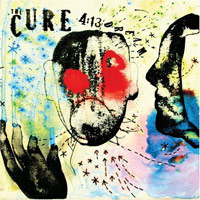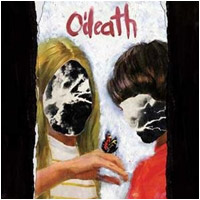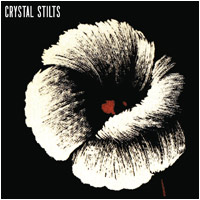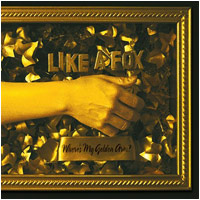
4:13 Dream
Suretone/Geffen
While the Cure can now celebrate 30 years of being a band, for the last half of its existence the group has been merely skating by on their reputation as the kings of mopish post-punk. In that time, they’ve only released three studio albums, consisting of the abysmal (Wild Mood Swings), the relatively decent (Bloodflowers), and the inconsequential (The Cure). In fact, it’s been almost two decades since they’ve put together a record truly worthy of their legacy, 1989’s Disintegration, and it had begun to look like their once ever-evolving juxtaposition of pop and gothic motifs had finally reached its expiration date. (The irony being that Cure head Robert Smith had ceased his continual promising of an impending break-up.)
Preceding the release of 4:13 Dream, Smith had made several proclamations. First, that the band was returning to a more minimal sound akin to their early years, and second, that they would be releasing a double-album. The former, while debatable, probably isn’t the case, and the latter definitely didn’t come to fruition. One thing is certain: guitarist Porl Thompson has returned to the fold for the first time since Wish, and his work can be heard all over the record. In many ways, 4:13 most closely resembles the double-album the band did release, 1987’s Kiss Me, Kiss Me, Kiss Me. The Cure ventures into acid-drenched funk on “Freakshow” (a la “Hey You!”) only to counteract with the darkened bluster of “The Real Snow White” (a la “Like Cockatoos”). It’s when Smith ventures to wider ends of the spectrum that the album shines. The acoustic reverie of “Sirensong” is angelic as anything he’s written and benefits from Thompson’s slide work, while the Pornographic electronic abyss of “The Scream” is the first time he’s sounded convincingly wracked in years. The highs don’t necessarily make up for the lows—lead single “The Only One” is ostensibly the same song Smith has been writing over and over again since Wish—but it does show that there’s still a good deal of life left in these corpses.
Stephen Slaybaugh

Broken Hymns, Limbs, and Skin
Kemado
What is it about O’Death’s sound that qualifies them as “alternative?” Is it simply matching their traditional melodies and song structures with big rock beats? Is it the unabashed gang screeching of vocalists Greg Jamie or Gabe Darling? Is it the formed-at-a-New-York-college pedigree? Is O’Death the same Americana filtered through well-read traveler, punk sound that Old Time Relijun or Dr. Dog or Gogol Bordello or Flogging Molly or the Frames or even the Decemberists have all come to hone into a decently popular genre? What is the genre? Can it be called alternative anymore? Gypsy grunge? Post-pirate? Even Modest Mouse has been allowing this pirate ship yo-ho-ho and a bottle of rum swashbucklery seep into their sound. The issue at hand is O’Death’s mastery of skeletal banjos, backporch acoustic guitars, wailing fiddles, athletic drums, propulsive bass and pub jam crowd vocals amalgamated into a traditional sound that still manages to be young, alive and current. How easy it would be for them to just go through the motions of traditional music and pluck away with no intensity, and yet Broken Hymns, Limbs, and Skin is full of energy, sincere imagination and well written songs that O’Death escapes the trap of delivering a plodding old-timey record.
No doubt that Locust producer Alex Newport had a hand in capturing the band’s live sound, as this records sound so present, like they’re blasting away in a tiny bar with a giant sound system rather than on the other end of a church. Not all of the songs are rollicking, booze-swilling rave-ups. “Home” is a mournful, funereal, “broken, empty hymn.” “Angeline” is an autumnal ode to a woman “tired of [her] tragedies.” “A Light That Does Not Dim,” the most propulsive song on the record, is “a reflection of the warmth” that drummer David Rogers-Berry’s late fiance brought his world. Broken Hymns, Limbs, and Skin reaches far beyond the sea-faring themes or base drinking tunes that should stereotypically be present on a record like this and succeeds in creating a compelling sound at the same time. If this seafaring punk is a sound that demands popularity, then O’Death has earned the right to captain the ship.
Michael P. O’Shaughnessy
MP3: “Lowtide”

Alight of Night
Slumberland
For many, it will be hard to crack through the deafening hype surrounding Crystal Stilts’ official debut and give them the benefit of being much more than just another gang of Brooklynites with a keen sense of style and a priceless record collection. Even those that start to dig under it will be hard-pressed not to dismiss the album as nothing more than a blurry placebo of jangled cave-pop—great mimicry, but incapable of actually defining themselves as individuals. Blame it on the company they’ve taken up. Yes, Alight the Night is nothing groundbreaking, but after sitting with it for some time it’s hard not become entranced by the extreme dourness of their hypno wall-of-sound.
Crystal Stilts are unknowingly vying for membership with the new Goths and/or the new Romantics. Neither is a counter-culture they seem to particularly connect with, but in the band’s cryptic wordplay and effete detachment, visions of Bahaus and the Associates appear in their psychedelic-garage whirl. “Bright Night” is the perfect contradiction between reverb-drenched VU ruminations on darkness and the deathly and dreamy lethargic ring of guitars and tambourines seemingly floating in a separate haze. Even when the tempos are ratcheted to speeds that might parallel the amphetamine pop of Josef K and Orange Juice, as on “Sin King,” singer Brad Hargett’s laconic moan makes for another layer of drowsy atmosphere. Most songs his vocals are doubled, and as he struggles to sync with himself, the affect is even more an opiate.
Amongst all the doom and gloom, though, Alight of Night is rife with pop melodies painted in gold leaf. From the Clean in slow-motion organ-wheeze of “Prismatic Room” to the ‘50s ballroom balladry of “The City in the Sea,” the songs have an eerie familiarity but stray, woozily, from imitation. Perhaps it’s the band’s indifference that shields their ingenuity from sunlight, that or they’re already half-dead—a trait that only makes them all the more intriguing. Call it zombie rock.
Kevin J. Elliott

Microcastle
Kranky
If there is one thing that can be said about Deerhunter, it’s that they are constantly evolving. Turn It Up Faggot (2005) explored murky, Liars and P.I.L. influenced post-punk. Cryptograms and Fluorescent Grey EP, from 2007, were gauzy, drone-based guitar records, almost shoegaze in nature. The one thread that runs between all the records is the murkiness of the sound. It’s thick, dense, and the songs sound like they’re being played underwater. In an interview, Deerhunter frontman Bradford Cox said that the band was running everything—guitars, bass, and vocals—through a Digitech guitar pedal called the Digidelay, no doubt a reason for the similar sound.
The reason I’m so concerned with this is that the thing that’s missing from Microcastle is that murkiness and gauze. All of the sounds are well separated and crisp. Each guitar comes through on its own, and the vocals are up front and relatively clear. It sounds a little more like Bradford Cox’s Atlas Sound album. Album opener “Cover Me (Slowly)” is a bit of a red herring. Like a track from Cryptograms, it’s all swirly delayed vocals and cascading guitars. After that, things change up a bit. “Never Stops” has some great My Bloody Valentine style feedback through the end. “Little Kids” builds into a wall of guitars a la Glenn Branca. Both the title track and “Twilight At Carbon Lake” have an almost Phil Spector sound with loads of reverb heaped on ‘50s rock & roll chord progressions. The big change is in the clear sound of Cox’s vocals. Cox doesn’t have the best voice and worked better when used as an instrument, and as a result this album suffers for it. Ultimately, though, this might be what helps Deerhunter find a larger audience. The crisper vocals add more hooks to the songs and give a little more on which to latch. Microcastle is Deerhunter’s most accessible record yet, and it’s a good record. But at this point, all of the mystery is gone.
Tom Butler

Where’s My Golden Arm?
Transit of Venus
The best that Like a Fox’s label can come up with to sell them is to say that they “have some interesting stories to tell.” It may just be a terrible press release, but it’s also an pretty good indication of what to expect from this album, which has a few good moments and not much more.
Synths bubble up here and there under feather-light lyrics that “come on like a tickle” (seriously, they put that in a rock and roll song). There’s an interesting time warp effect in “Time Stands Still,” and the closing track, “Just a Light Hit,” has a pretty convincing sing-along chorus after a several minutes of what you might call a Flaming-Floyd emulsion. It’s easy to imagine Like a Fox trying to get the crowd clapping along to “Night Person,” and the drunks in the audience might appreciate the sluggish tempo, but the folks trying to work up a good time will find themselves unaided by this or the band’s other attempts to bolster their lackluster songwriting with hackneyed conventions. Too slow to be twee, too cute to rawk, and with too many overt references to Mercury Rev and the aforementioned Lips to be considered a band on their own path, Like a Fox have the potential to sell hundreds of records to the Fountains of Wayne fan club.
Matt Slaybaugh
ALBUM REVIEWS
The Sea and Cake, Car Alarm
Tobacco, Fucked Up Friends
Magnetic Morning, A.M.
Her Space Holiday, XOXO, Panda and the New Kid Revival
Deerhoof, Offend Maggie
Holly Golightly and the Brokeoffs, Dirt Don't Hurt
Rachael Yamagata, Elephants... Teeth Sinking Into Heart
Dungen, 4
Juana Molina, Un Dia
Crystal Antlers, Crystal Antlers EP
Fucked Up, The Chemistry of Common Life
Catfish Haven, Devastator
TV on the Radio, Dear Science
Mogwai, The Hawk Is Howling
